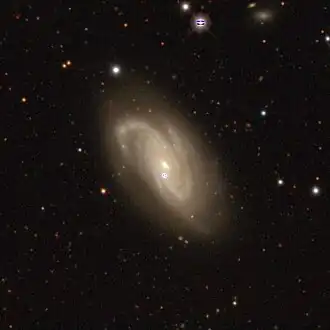NGC 1616
| NGC 1616 | |
|---|---|
 A Legacy Surveys image of NGC 1616 | |
| Observation data (J2000 epoch) | |
| Constellation | Caelum |
| Right ascension | 04h 32m 41.80s[1] |
| Declination | −43° 42′ 55.00″[1] |
| Redshift | 0.01488±0.000033[1] |
| Distance | 213 Mly (65.58 Mpc)[1] |
| Apparent magnitude (V) | 12.5[1] |
| Characteristics | |
| Type | SAB(rs)bc pec?[1] |
| Size | 116,000 ly |
| Apparent size (V) | 1.905′ × 1′[1] |
| Notable features | N/A |
| Other designations | |
| ESO 251-10,[1] PGC 15479,[1] LEDA 15479,[1] MCG -07-10-013[1] | |
NGC 1616 is an intermediate spiral galaxy located around 213 million light-years away in the constellation Caelum.[2] NGC 1616 was discovered on October 24th, 1835 by the astronomer John Herschel, and its diameter is 116,000 light-years across.[1][3] NGC 1616 is not known to have much star-formation, and it is not known to have an active galactic nucleus.[4][1]
References
- ^ a b c d e f g h i j k l m "By Name | NASA/IPAC Extragalactic Database". ned.ipac.caltech.edu. Retrieved 2024-04-01.
- ^ "NGC 1616 - Intermediate Spiral Galaxy in Caelum | TheSkyLive.com". theskylive.com. Retrieved 2024-04-01.
- ^ "NGC 1616 - Galaxy - SKY-MAP". www.wikisky.org. Retrieved 2024-04-01.
- ^ "New General Catalog Objects: NGC 1600 - 1649". cseligman.com. Retrieved 2024-04-01.
External links
 Media related to NGC 1616 at Wikimedia Commons
Media related to NGC 1616 at Wikimedia Commons